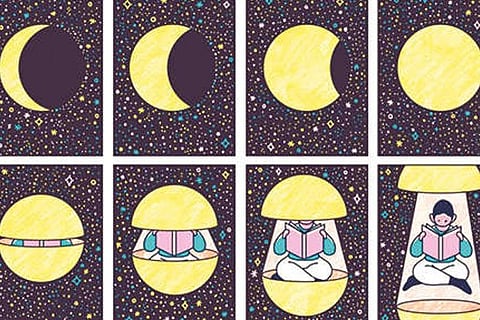

New York
About a year into the pandemic, Marcela Rafea began waking up consistently at 3 am, her mind racing.
She would creep out of bed and tiptoe into the living room, where she would meditate, try a few yoga poses and open the window to hear the leaves rustle, the cars rush by and the dogs bark.
Then, at 6 am, she crawled back into bed and would sleep again until her youngest child woke her for the day at 7 am
“I needed that night wakefulness to make up for the time that I didn’t have for myself,” said Rafea, a 50-year-old photographer and mother of three who lives in Oak Park, Ill.
Unbeknown to Rafea, she had naturally reverted back to a sleep cycle that was believed to be standard in multiple cultures in the late Middle Ages through the early 19th century.
During that time, many people went to sleep around sundown and woke three to four hours later. They socialised, read books, had small meals and tried to conceive children for the next hour or two before going back for a second sleep for another three to four hours. It was only when artificial light was introduced that people began forcing themselves to sleep through the night, said A Roger Ekirch, a professor of history at Virginia Tech and the author of “The Great Sleep Transformation.”
Now that many people are making their own schedules, working from home and focusing more on self-care, there has been a return for some to the idea of a segmented sleep cycle — voluntary and, given the stress levels of the last two years, not.
So are we simply reverting to our long forgotten, natural sleep cycle? And could this be the cure for those deemed middle-of-the-night insomniacs?
Professor Ekirch, who has studied segmented sleep for the past 35 years, said there are more than 2,000 references to it from literary sources: everything from letters to diaries to court records to newspapers, plays, novels and poetry, from Homer to Chaucer to Dickens.
“The phenomenon went by different names in different places: first and second sleep, first nap and dead sleep, evening sleep and morning sleep,” said Benjamin Reiss, a professor of English at Emory University and the author of “Wild Nights: How Taming Sleep Created Our Restless World.”
Back then, in addition to being a useful time for conceiving, the wakeful period was also believed to be a prime time for taking potions and pills and for aiding digestion (one would sleep on one side of the body during the first sleep, and then one the other side during the second sleep), Professor Ekirch said.
There was no pressure to get to the factory floor on time, to catch a train or to send children off to school, as most work was done in or near the home, Professor Reiss said. Sleep wasn’t governed by the clock, but by the rhythms of night and day as well as by changes in the season.
It may make some people feel more fatigued and drowsy throughout the day, said Nicole Avena, a health psychologist and assistant professor of neuroscience at Mount Sinai School of Medicine. But returning to sleep patterns from the Middle Ages isn’t for everyone, she said, suggesting that segmented sleep should be tried only by those who are already having sleep issues.
Braff is a journalist with NYT©2022
The New York Times
Visit news.dtnext.in to explore our interactive epaper!
Download the DT Next app for more exciting features!
Click here for iOS
Click here for Android